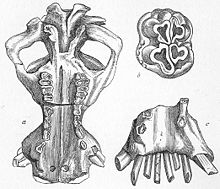
Back Troskol (Hexaprotodon) AVK Hexaprotodon Catalan Hexaprotodon CEB Hexaprotodon Spanish Hexaprotodon Basque Hexaprotodon French הקספרוטודון HE Hexaprotodon Croatian Hexaprotodon Hungarian Hexaprotodon Italian
| Hexaprotodon Temporal range: Latest Miocene to Late Pleistocene
| |
|---|---|

| |

| |
| Hexaprotodon sivalensis skull elements | |
| Scientific classification | |
| Domain: | Eukaryota |
| Kingdom: | Animalia |
| Phylum: | Chordata |
| Class: | Mammalia |
| Order: | Artiodactyla |
| Family: | Hippopotamidae |
| Subfamily: | Hippopotaminae |
| Genus: | †Hexaprotodon Falconer & Cautley, 1836 |
| Type species | |
| †Hexaprotodon sivalensis | |
| Species | |
|
See text | |
| Synonyms | |
|
Hexoprotodon [sic][1] | |
Hexaprotodon is an extinct genus of hippopotamid known from Asia and possibly Africa and Europe. The name Hexaprotodon means "six front teeth" as some of the fossil forms have three pairs of incisors.[2][3] The pygmy hippopotamus was historically placed in the genus, but today is generally placed in its own genus. The core Asian members of the genus ranged from the Indian subcontinent to Southeast Asia, and are thought to have had an aquatic ecology similar to that of the living common hippopotamus. The last members of the genus became extinct during the Late Pleistocene, perhaps as recently as 15,000 years ago.
- ^ Seth, S. (1993), New Perspectives in Anthropology, M.D. Publications, p. 333, ISBN 9788185880198
- ^ Boisserie, Jean-Renaud (2005). "The phylogeny and taxonomy of Hippopotamidae (Mammalia: Artiodactyla): a review based on morphology and cladistic analysis". Zoological Journal of the Linnean Society. 143: 1–26. doi:10.1111/j.1096-3642.2004.00138.x.
- ^ Hexaprotodon, The Paleobiology Database, läst 19 mars 2013.